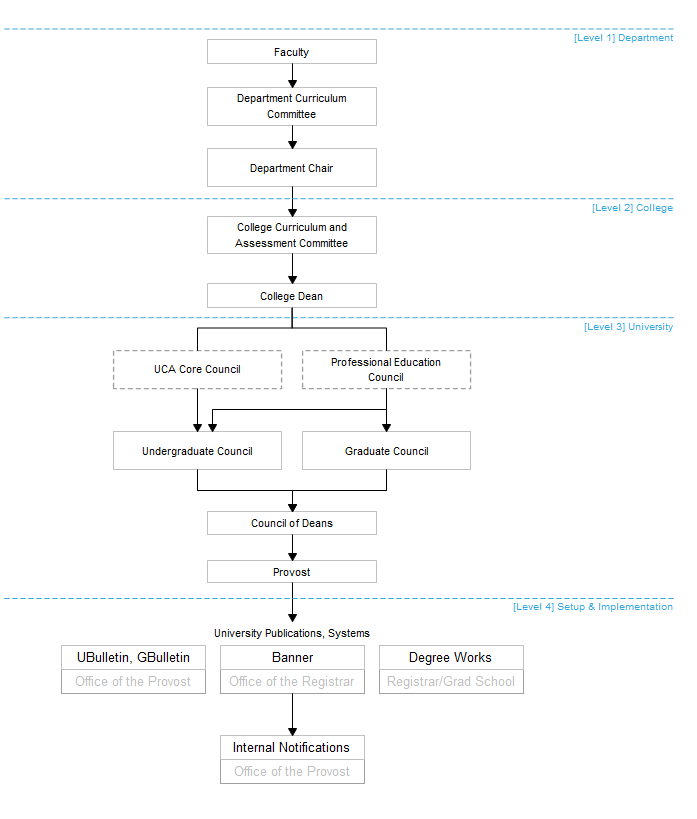The process outlined here applies to course proposals (use Curriculum Form U1 or G1), other action items that are not program proposals (use Curriculum Form U2-A or G2-A), information items (use Curriculum Form U2-I or G2-I), and conversion of existing courses for online or hybrid delivery (use Curriculum Form U2-O or G2-O). New course proposals involving online or hybrid delivery will use Curriculum Form U2-O or G-2O in conjunction with the course proposal form. For additional information about the forms to use for curriculum change processes, see the Required Forms page. For a chart of the change process, see Figure 1.
Note that some curricular changes—notably those related to the creation, renaming, reconfiguration, or deletion of academic programs—require notification and/or approval beyond the internal curriculum change process; for those changes, additional forms are generally required. These additional forms are listed in the Program Proposal Processes page.
Note: For forms and processes used with certain academic changes that are administrative rather than curricular—e.g., changing the name of an academic unit (department, center, college, etc.)—see Other Change Processes.
Consult the Director of the UCA Core, the Associate Provost for Institutional Effectiveness, and/or the Graduate Dean before initiating major curriculum change.
Level 1
A proposal is prepared, typically by one or more faculty members, and brought before the department.
The proposal is reviewed by the department (curriculum committee and, then, chair). If recommended, it is forwarded to the dean who distributes it to the college curriculum and assessment committee. If not recommended, it is returned to the proposer.
Level 2
The college curriculum and assessment committee reviews the proposal. If recommended, it is forwarded to the dean of the college. If not recommended, it is returned to the proposer.
The college dean reviews the proposal. If the proposal is not recommended by the college dean, it is returned to the proposer. If the proposal is recommended it is forwarded as indicated in Step 5.
Level 3
During the academic year, a proposal must be submitted to the appropriate council at least one month before the meeting at which action is desired. Summer submissions may be delayed until the fall semester.
- If the proposal affects a teacher education program, the dean forwards it to the Professional Education Council (PEC). If the PEC recommends the proposal, it is forwarded to the Undergraduate Council or Graduate Council as appropriate. If the PEC does not recommend it, it is returned to the proposer.
- If the proposal affects the UCA Core program, it is forwarded to the UCA Core Council. If the UCA Core Council recommends the proposal, it is forwarded to the Undergraduate Council. If the UCA Core Council does not recommend it, the proposal is returned to the proposer.
- If the proposal affects the undergraduate curriculum but does not affect a teacher education program or the UCA Core program, it is forwarded directly to the Undergraduate Council. If the Undergraduate Council recommends the proposal, it is forwarded to the Council of Deans. If it is not recommended, the proposal is returned to the proposer.
- If the proposal affects the graduate curriculum but does not affect the teacher education program, it is forwarded directly to the Graduate Council. If the Graduate Council recommends the proposal, it is forwarded to the Council of Deans. If it is not recommended, the proposal is returned to the sender.
- If the proposal affects both the undergraduate and the graduate curricula (e.g., a proposal for a double-listed course – a course listed at both the 4000 and 5000 levels), it is forwarded to both the Undergraduate Council and Graduate Council for simultaneous review. Each council forwards recommended proposals to the Council of Deans and returns proposals that are not recommended to the proposer.
Level 4
If the proposal is recommended by the Council of Deans and approved by the Provost, the change is incorporated (as relevant) in the Undergraduate Bulletin and/or Graduate Bulletin, the Banner system, and Degree Works and internal notification is made. Internal notification is accomplished primarily by return of a copy of the signed curriculum change form(s) to the originating department.

